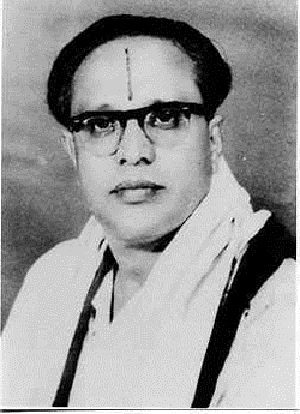
Palghat Rama Bhagavathar, known for his dedication and delightful music, is a great name in the field of Carnatic music. Palghat Rama Bhagavatar was born on 5th June 1888, at Munda Mukha near Shoranur, to village revenue official Kasturi Ranga Iyer and Alamelu Mangai, as their fifth and last son. Kasturi Ranga Iyer had a modest income which helped meet the barest needs of the family. They had a small, unpretentious home with a well in the backyard. The village was on the banks of the Bharata Puzha river. The presiding deity of the village was Lord Ayyappan. Rama Bhagavatar attended the village school and learnt the Vedas and sastra-s. His elder brother Venkatakrishna Bhagavatar, who had a flair for classical music, became an exponent of Kathakali padams.
He taught young Raman to sing along with him. Rama Bhagavatar was then eight years of age. This laid a firm foundation in young Raman, who in addition to the padams, also absorbed Rama Bhagavatar’s quest for a career in classical music took him to nearby Thondikulam, where he was introduced to the stern Anantarama Bhagavatar. It was perhaps providential that he left his village, for flood waters of the Bharata Puzha soon devastated it. Anantarama Bhagavatar was a regular visitor to Kumbakonam, then the centre of classical music. He took Rama Bhagavatar along with him to listen to the music of Maha Vaidyanatha Sivan. (It is said he posed as a tantric to gain admission into Sivan’s home). He also started taking Rama Bhagavatar along with him to Tanjavur and other places nearby to listen to the great musicians there. One of the musicians whose performances Anantarama Bhagavatar frequently attended was the late Umayalpuram Swaminatha Iyer who accepted Rama Bhagavatar as his live-in disciple after putting him through a rigorous test. Maharajapuram Viswanatha Iyer was a fellow sishya and the two became close friends. Rama Bhagavatar’s tutelage under Swaminatha Iyer was an opportunity to learn a number of kritis of Tyagaraja from a scion of the great composer’s musical lineage. Rama Bhagavatar spent the next eight years in Kumbakonam, learning the nuances of various ragas, in the process evolving his own style of manodharma.
Rama Bhagavatar also learnt a large number of kritis of other great vaggeyakaras like Muthuswami Dikshitar, Syama Sastry, Gopalakrishna Bharati, Swati Tirunal, Patnam Subramania Iyer, Jayachamaraja Wodeyar, and Mysore Vasudevachar. In addition to kritis in Telugu, Kannada, Tamil and Malayalam, he also learnt a few abhangs in Marathi, thanks to his association with violin maestro Mysore T. Chowdiah, who temporarily moved from Mysore to Old Kalpathy at the bidding of Rama Bhagavatar and accompanied him on the violin in many performances. The late Maharaja of Mysore Jayachamaraja Wodeyar regularly invited Rama Bhagavatar to his durbar during Dasara for a special performance and honoured him. So did the late Maharaja and Maharani of Travancore. Nobel Laureate C.V. Raman bestowed on him the title of Gayaka Kesari. Rama Bhagavatar was 23 when he married Rukmini. She was then only nine. Rama Bhagavatar settled down in Old Kalpathy, Palghat, in 1910 and remained a resident of that village till his last days in 1957. His house is still going strong – the home of his children, grandchildren and even great grandchildren. Till his last breath, Rama Bhagavatar performed the annual guru pooja in memory of his guru. Rama Bhagavatar and Rukmini had seven sons and four daughters. His second son M.R. Seshamani who for sometime accompanied Rama Bhagavatar in his concerts, later become a disciple of G.N. Balasubramaniam. His fourth son, Lakshmi Narayanan, accompanied Rama Bhagavatar for the rest of his musical career.
Rama Bhagavatar’s residence was always open to those who wanted to learn kritis from him, for which he charged no fees. Among his important disciples were K.V. Narayanaswamy, Puducode Krishnamurthy, and K.S. Sankaran Nambudiri. Rama Bhagavatar’s last performance was in June 1957, in the precincts of the Kasi Viswanatha temple at Kalpathy, during its kumbhaabhishekam. He was accompanied by Kandadevi Alagiriswamy (violin) and Palghat T.S. Mani Iyer (mridanga). He had made his debut at this venue years ago.
A fortnight later, he passed away on 26 May 1957 while performing sandhya vandanam at the Nila riverin the morning. Rama Bhagavatar was a great devotee of Lord Rama. He lived a life devoid of ego, anger and avarice. He shunned publicity, and music was the medium through which he sought to establish communion with Lord Rama. His Rama nee samanam evaru in Kharaharapriya still remains unsurpassed. He was a true nadopasaka.


